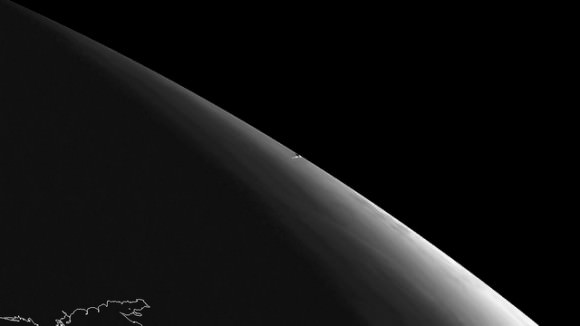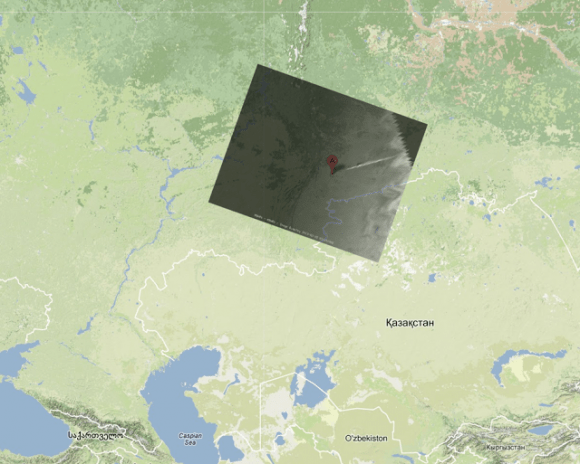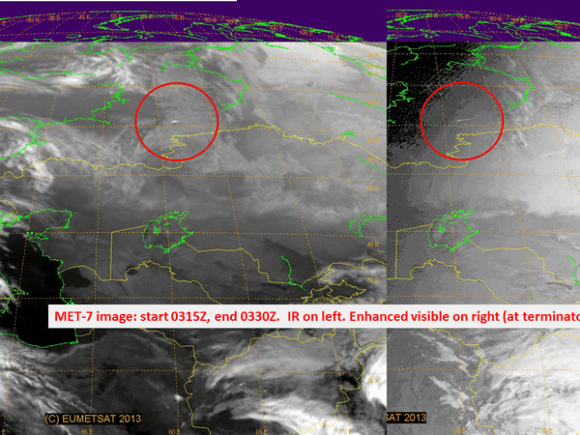The meteor that streaked over the skies of Russia — creating a shockwave that shattered windows, injuring upwards of 1,000 people — is not related to the asteroid that will whiz past Earth later today, (Feb.15), NASA has confirmed.
As many of our readers have noted in comments on our previous story on the Russian meteor, the trajectory of the Russian meteorite was significantly different than the trajectory of the asteroid 2012 DA14, making it a completely unrelated object.
“Information is still being collected about the Russian meteorite and analysis is preliminary at this point,” NASA said in a statement. “In videos of the meteor, it is seen to pass from left to right in front of the rising sun, which means it was traveling from north to south. Asteroid DA14’s trajectory is in the opposite direction, from south to north.”
Images and video of the Russian bolide taken from satellites in Earth orbit confirm the trajectory:

Reports are still coming in, but perhaps more than 1,000 people were injured, according to a statement from the Russian Emergency Ministry, primarily by glass cuts when windows were shattered from the shockwave blast. The vapor trail of the meteor was visible before the blast, so many people were standing in front of windows, looking at the trail visible across the sky.
The meteor appeared in the skies at around 09:25 a.m. local time in the Chelyabinsk region, near the southern Ural Mountains. It disintegrated and ‘exploded’ about 30-50 kilometers above Earth’s surface. The fireball blinded drivers and a subsequent explosion blew out windows. Reports of damaged buildings are being checked.
Initial estimates for the Russian Meteor are that it was a 1.5 meter-wide object weighing about 10 tons, traveling at 15 km/s.

Nature News is reporting that this morning was the largest recorded object to strike the Earth in more than a century. “Infrasound data collected by a network designed to watch for nuclear weapons testing suggests that today’s blast released hundreds of kilotonnes of energy. That would make it far more powerful than the nuclear weapon tested by North Korea just days ago and the largest rock crashing on the planet since a meteor broke up over Siberia’s Tunguska river in 1908<" Nature News said.
[caption id="attachment_100015" align="aligncenter" width="580"] Satellite images from the European MET-7 weather satellite. Credit: EUMETSAT. [/caption]
Satellite images from the European MET-7 weather satellite. Credit: EUMETSAT. [/caption]
We’ll continue to provide updates on this story as they become available.


Just woke up and heard the news. First thought…”Was it a co-orbital of 2012 DA14?” Then I switched off the boob and headed over here. Thanks for the clarification. I’ll bet there are some interesting chunks laying in the snow somewhere? Hard to find unless pieces came to rest on a frozen lake or river?
This is proof that it’s not what you see (DA14 2012), it’s what you DON’T see!
That seems to be so horribles 😮
its pretty.. finally in my lifetime i have witnessed a meteorite kissing our mother earth <3 xD 🙂 😀
Hello, i’m from Russia. Me and my friends have got a super abilities after meteorite impact 😀
But seriously, it was unexpected.
p.s. Sorry for bad English
abilities? come on you are making that up 🙂
Those scientists who said Tunguska Russia in 1908, was a volcano eruption, a starship UFO nuke explosion and among “OTHER FAIRY TALES” they described, now have the LARGEST OF CLUES! Yesterdays rock was pure PROOF w/many videos, of a simple “AIR BLAST” by a big 10-ton rock. Tunguska was a massive rock air blast.
Biblical Sodom & Gomorrah was prob the same kind of thing w/a bigger rock(?1/2-mile+?). The Clovis people, Woolly Mammoths & other animals of that time prob were hit by the same thing (a rock)on that made it thru to the ice sheet in Canada. Some were rock meteors cores, some were iron meteor cores.
Makes “US ALL” wonder what is the next one going to be. A 1/2 mile rock meteor? A 1/2 mile iron core meteor? Maybe both will be bigger? It not “IF”, but “WHEN”. I shutter to think about the devastation. God Bless us all….PEACE OUT!
“Initial estimates for the Russian Meteor are that it was a 1.5 meter-wide object weighing about 10 tons” ?
NASA has an estimate of 15 meters and 7000 tons:
http://www.nasa.gov/mission_pages/asteroids/news/asteroid20130215.html
well, we’ll get better data, I guess.
It’s funny how all the news sites refer to this as ‘the Russian meteor’, but I’m pretty sure that the meteor wasn’t built by the Russians ;p
Extended meteor track crosses Roma. What does it mean? Coincidence?
I’m from Russia and this event is usually for Russia. every day we have meteorites fall, … oh I forgot to feed my bear borsh, so goodbye
Just assuming that the two asteroids *could* be related on a previous flyby. Suppose, for example, the larger of a pair of asteroids was deflected by the Moon (or Earth) gravity out of the solar plane? How would one determine this?
My proposal: input the negative-velocity orbits of the Sun, the Earth, and the Moon, as well as both asteroids, into the Parker Sochacki solution to the Picard iteration (Google ‘Parker Sochacki Picard Rudmin celestial mechanics’ for info). Now run it as an initial value problem, and see what happens on previous passes. If they recombine, then you can conclude that they were related.
And here we are worried about day to day existance.One shot from the universe and everything will start all over again…the power of nature is something we can’t control. Nature and sky has been my fascination for years now and here is the outcome.
http://www.marcinprasal.com/fine-art-sky/
Dear Michael James Rudmin and Others:
I agree with you.
I will note that in the official NASA online article which states that there is no association of the two objects, there is an Editor’s Introductory Paragraph. That Introductory Paragraph qualifies everything in the article by explaining that NASA is still in the
process of determining the trajectory of the Russian Meteorite.
If NASA has not yet determined the true trajectory of the Russian Meteorite, how can it be said with certainty now that the two objects have no relationship to each other?
Michael, I believe your posited explanation is plausible. Other possibilities must be
thoroughly investigated and ruled in or out.
It is too much of a coincidence that the two objects approached/struck the earth
so close in time, to justify shrugging it off as a mere coincidence, without a complete investigation.
I have always thought that NASA’s regular, continuous, observation and monitoring of
near-earth objects and the area within 1 billion miles of earth is not as good as it should be.
NASA’s monitoring of outer space debris, asteroids, meteors, comets, and other objects in outer space, must be improved.
And especially now, we should not just laugh off the proximity in time of these two events as a happenstance, without an exhaustive investigation.
And I mean extremely thorough and exhaustive.
Because I believe that, regardless of the outcome of the investigation, we will learn a great deal from it, and it will be invaluable to us immediately in the conduct of our monitoring and observation of the area within one billion miles of earth, and more.
It will vastly improve our planetary security.
Sincerely yours,
CALEB BOONE,
Hays, Kansas.
Correct me if I’m wrong, but it was my understanding that an asteroid is much more likely to strike a planet as a result of being entrapped by its gravitational pull, looping around, then striking at a shallow angle from the opposite direction than the one from which it approached. I’m not understanding why NASA would use the direction of approach to confirm the most unlikely possible scenario that these are unrelated. North to South shallow entry is exactly what one could expect of a large asteroid approaching from the South, making an indirect strike.